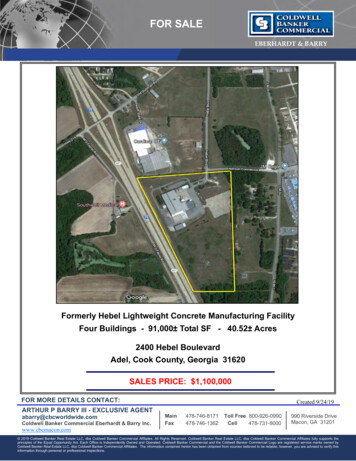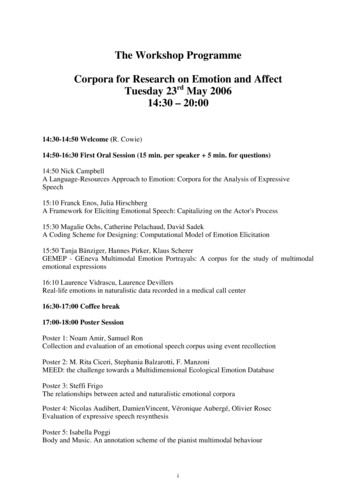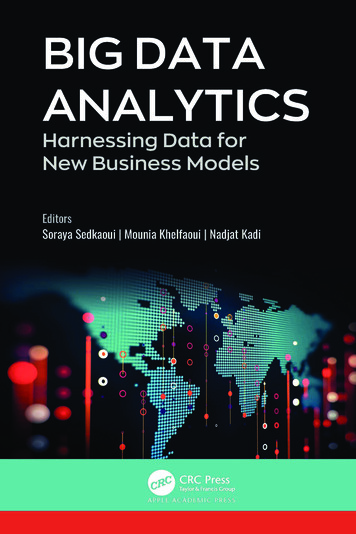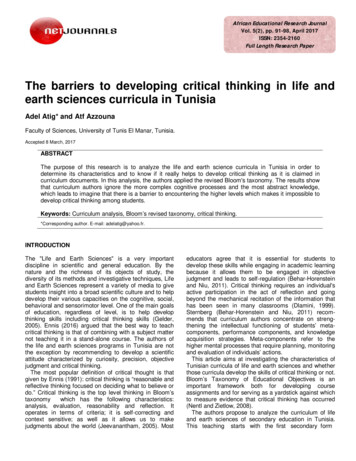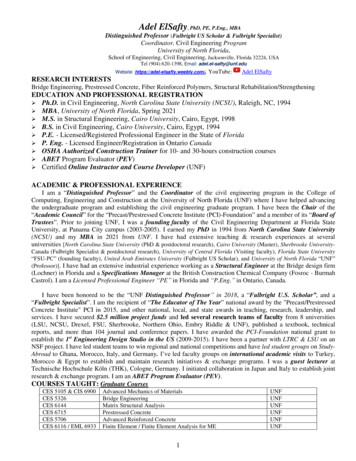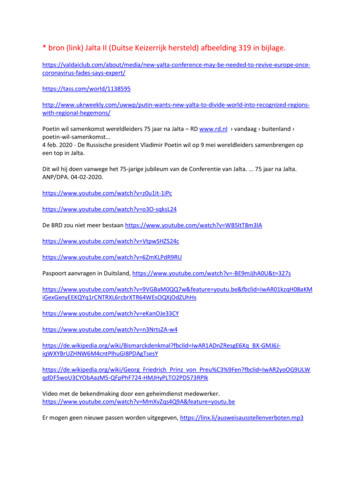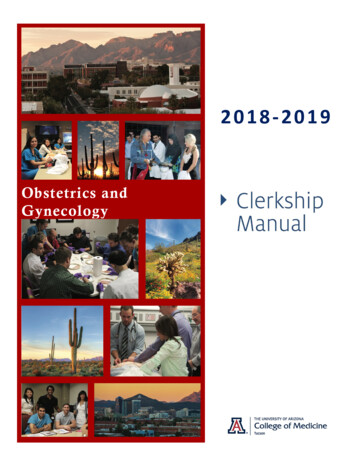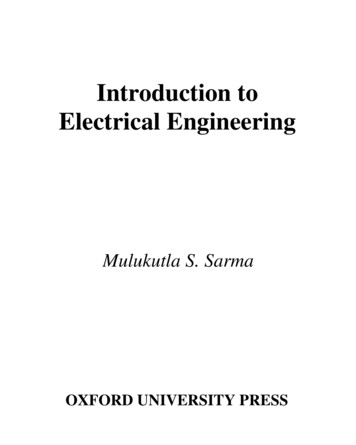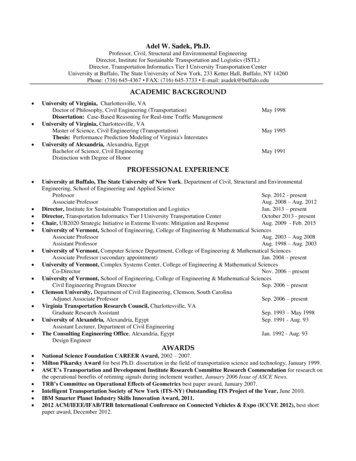
Transcription
Adel W. Sadek, Ph.D.Professor, Civil, Structural and Environmental EngineeringDirector, Institute for Sustainable Transportation and Logistics (ISTL)Director, Transportation Informatics Tier I University Transportation CenterUniversity at Buffalo, The State University of New York, 233 Ketter Hall, Buffalo, NY 14260Phone: (716) 645-4367 FAX: (716) 645-3733 E-mail: asadek@buffalo.eduACADEMIC BACKGROUND University of Virginia, Charlottesville, VADoctor of Philosophy, Civil Engineering (Transportation)Dissertation: Case-Based Reasoning for Real-time Traffic ManagementUniversity of Virginia, Charlottesville, VAMaster of Science, Civil Engineering (Transportation)Thesis: Performance Prediction Modeling of Virginia's InterstatesUniversity of Alexandria, Alexandria, EgyptBachelor of Science, Civil EngineeringDistinction with Degree of HonorMay 1998May 1995May 1991PROFESSIONAL EXPERIENCE University at Buffalo, The State University of New York, Department of Civil, Structural and EnvironmentalEngineering, School of Engineering and Applied ScienceProfessorSep. 2012 - presentAssociate ProfessorAug. 2008 – Aug. 2012Director, Institute for Sustainable Transportation and LogisticsJan. 2013 – presentDirector, Transportation Informatics Tier I University Transportation CenterOctober 2013 - presentChair, UB2020 Strategic Initiative in Extreme Events: Mitigation and ResponseAug. 2009 - Feb. 2015University of Vermont, School of Engineering, College of Engineering & Mathematical SciencesAssociate ProfessorAug. 2003 – Aug 2008Assistant ProfessorAug. 1998 – Aug. 2003University of Vermont, Computer Science Department, College of Engineering & Mathematical SciencesAssociate Professor (secondary appointment)Jan. 2004 – presentUniversity of Vermont, Complex Systems Center, College of Engineering & Mathematical SciencesCo-DirectorNov. 2006 – presentUniversity of Vermont, School of Engineering, College of Engineering & Mathematical SciencesCivil Engineering Program DirectorSep. 2006 – presentClemson University, Department of Civil Engineering, Clemson, South CarolinaAdjunct Associate ProfessorSep. 2006 – presentVirginia Transportation Research Council, Charlottesville, VAGraduate Research AssistantSep. 1993 – May 1998University of Alexandria, Alexandria, EgyptSep. 1991 - Aug. 93Assistant Lecturer, Department of Civil EngineeringThe Consulting Engineering Office, Alexandria, EgyptJan. 1992 - Aug. 93Design EngineerAWARDSNational Science Foundation CAREER Award, 2002 – 2007.Milton Pikarsky Award for best Ph.D. dissertation in the field of transportation science and technology, January 1999.ASCE’s Transportation and Development Institute Research Committee Research Commendation for research onthe operational benefits of retiming signals during inclement weather, January 2006 Issue of ASCE News.TRB’s Committee on Operational Effects of Geometrics best paper award, January 2007.Intelligent Transportation Society of New York (ITS-NY) Outstanding ITS Project of the Year, June 2010.IBM Smarter Planet Industry Skills Innovation Award, 2011.2012 ACM/IEEE/IFAB/TRB International Conference on Connected Vehicles & Expo (ICCVE 2012), best shortpaper award, December 2012.
FUNDED RESEARCH PROJECTS Transportation Informatics University Transportation Center (TransInfo UTC): Harnessing the Power of Big Data inSupport of USDOT Strategic Goals. Funded by the U.S. Department of Transportation, the Research and InnovativeTechnology Administration. October 2013 – September 2017. Principal Investigator ( 4,261,710). CHS: Small: Modeling Cyber Transportation and Human Interaction in Connected and Automated Vehicles. Fundedby the National Science Foundation. December 2014 – November 2017. ( 499,952). Co-Principal Investigator withSean Wu (PI), Chunming Qiao, Kevin Hulme. Percent Effort: 25%. Applications of Knowledge Discovery in Massive Transportation Data: The Development of a TransportationResearch Informatics Platform (TRIP). Funded by the Federal Highway Administration Exploratory ResearchProgram. ( 989,000). (March 2015 – February 2017). Co-Principal Investigator with CUBRC and Panagiotis Ch.Anastasopoulos (PI on the UB side). Percent Effort: 10%. IMS Staten Island Web and Smartphone Development, Deployment and Evaluation. Funded by New York StateDepartment of Transportation. June 2012 – December 2014. Principal Investigator ( 616,501). Percent Effort: 20%. Exploring Novel Applications of Archived Transportation Data: Predicting Freeway Crash Risk, Border CrossingDelay and Inclement Weather Impacts. Funded by the U.S. Department of Transportation through Region II UniversityTransportation Research Center. April 2012 – October 2013. Principal Investigator ( 150,000). Percent Effort: 50%. Addressing Design and Human Factors Challenges in Cyber-Transportation Systems. National Science Foundation.September 2010 – August 2013. ( 707,508). Co-Principal Investigator with Dr. Chunming Qiao, Kevin Hulme, andChangxu (Sean) Wu (Principal Investigator: Chunming Qiao). Percent Effort: 25%. An Evaluation of Likely Environmental Benefits of Lowest Fuel Consumption Route Guidance in the BuffaloNiagara Metropolitan Area. Funded by the Federal Highway Administration. October 2010 – September 2011.Principal Investigator ( 40,000). Percent Effort: 100%. Using TRANSIMS for On-line Transportation System Management during Emergencies. Funded by the FederalHighway Administration. November 2009 – May 2010. Principal Investigator ( 226,000). Percent Effort: 70%. Reducing Vehicle Miles Traveled through Smart Land-use Design. Funded by New York State Energy Research andDevelopment Authority. June 2009 – May 2011. Principal Investigator ( 103,622). Percent Effort: 60%. A Prototype Decision Support System for Optimally Routing Border Crossing Traffic Based on Predicted BorderCrossing Times. Funded by the U.S. Department of Transportation through Region II University TransportationResearch Center. January 2010 – December 2010. Principal Investigator ( 100,000). Percent Effort: 60%. Using TRANSIMS to Model University Campus Transportation Systems. Funded by the Federal HighwayAdministration. January 2009 – December 2009. Principal Investigator. ( 60,000). Percent Effort: 70%. Transportation System Management under Multiple Hazards – Phase II. Funded by the Federal HighwayAdministration. July 2009 – June 2010. Principal Investigator (35,000). Percent Effort: 65%. Freight Travel Demand Modeling under Multiple Hazards. Funded by the Federal Highway Administration. July2009 – June 2010. Co-principal Investigator ( 35,000). Percent Effort: 35%. Transportation System Management under Multiple Hazards – Phase I. Funded by the Federal HighwayAdministration. October 2008 – June 2009. Principal Investigator ( 55,000). Percent Effort: 65%. Integrated Land-use, Transportation and Environmental Modeling: Complex Systems Approaches and AdvancedPolicy Applications. Funded by the University of Vermont Transportation Center. September 2007 – August 2010.( 416,535). Principal Investigator. Percent Effort: 30%.
Implementing the TRANSIMS Model in Chittenden County. Funded by the U.S. Department of Transportation.November 2006 – February 2008. ( 250,000) A joint proposal with Resource Systems Group, Inc. PrincipalInvestigator of the UVM team. Percent Effort: 30%. Practicable Calibration Procedures to Enhance the Accuracy of Analytical and Micro-simulation Software forModern Four-Legged Single-Lane Roundabouts. Funded by the New England University Transportation Center(NETC). January 2006 – August 2007. ( 75,000). Principal Investigator (Co-Principal Investigators: Lisa AultmanHall and Per Garder). Percent Effort: 80%. Identification of Crash-Prone Traffic Flow States on Freeways Using Real-Time Surveillance Data. Funded by theNew England University Transportation Center (NEUTC). January 2006 – January 2007. ( 130,000). Co-PrincipalInvestigator (Principal Investigator: John Ivan). Percent Effort: 30%. Warrants for Exclusive Left-turn Lanes at Unsignalized Intersections and Driveways. Funded by the New EnglandUniversity Transportation Center (NETC). May 2006 – November 2007. ( 100,000). Co-Principal Investigator(Principal Investigator: John Ivan). Percent Effort: 50%. A Systems Approach for Civil and Environmental Engineering Education: Integrating Systems Thinking, InquiryBased Learning and Catamount Community Service-Learning Projects. Funded by the National Science Foundation.September 2005 – August 2008. ( 798,309). Co-Principal Investigator with Mandar Dewoolker, Maureen Newmann,and Donna Rizzo (Principal Investigator: Nancy Hayden). Percent Effort: 20%. Evaluation of the Effectiveness of Experimental Green Markings on the Bicycle Lanes on Williston Road. Funded bythe Vermont Agency of Transportation. (July 2004 – June 2006). ( 13,000). Principal Investigator. Percent Effort:100%. Extended Kalman Filter for the On-line Calibration of Traffic Simulation Models. Funded by the New EnglandUniversity Transportation Center (NEUTC). September 2003 – August 2004. ( 56,000). Principal Investigator (CoPrincipal Investigator: Donna Rizzo). Percent Effort: 75%. Development of a Decision Support System for the Design of Phytoremediation Strategies. Funded by the VermontNSF EPSCoR Program. June 2003 – August 2004. ( 25,000). Principal Investigator. Percent Effort: 100%. CAREER: Harnessing the Power of Computational Intelligence for Infrastructure Management and Control.Funded by the National Science Foundation. 2002 – 2007. ( 375,000). Principal Investigator. Percent Effort: 100%. Intelligent Adaptive Control for Dynamic Route Guidance. Funded by the New England University TransportationCenter (NEUTC). September 2002 – August 2003. ( 36,000). Principal Investigator. Percent Effort: 100%. Calibrating Traffic Simulation Models to Inclement Weather Travel Conditions with Applications to ArterialCoordinated Signal Systems. Funded by the New England Transportation Consortium (NETC). September 2002 –August 2004. ( 75,000). Principal Investigator (Co-Principal Investigator: Wael El-Dessouki. Percent Effort: 80%. Intelligent Transportation Systems Applications to Ski Resorts in New England and Northeastern New York State.Funded by the New England Transportation Consortium (NETC). September 2002 – February 2004. ( 60,000).Principal Investigator (Co-Principal Investigator: Randy Knapick). Percent Effort: 60%. A Research-Based Undergraduate Experience Focused on Systems Thinking, Information Technology andLaboratory Applications. Funded by the National Science Foundation. September 2002 – August 2003. ( 100,000).Co-Principal Investigator with Cully Hession and Donna Rizzo (Principal Investigator: Nancy Hayden). Percent Effort:25%. A Case Study of Intelligent Transportation Systems Deployment in Rural Vermont. Funded by the Vermont Agencyof Transportation (VTrans). October 1, 2001 – December 31, 2002. ( 30,000). Principal Investigator. Percent Effort:100%.
Using Simulation to Evaluate the Effects of Prohibiting Left-turn and the Resulting U-turn Movement. Funded bythe Ohio Department of Transportation (ODOT). September 1, 2001 – December 31, 2002. ( 100,000). Co-PrincipalInvestigator (Principal Investigator: Mashrur Chowdhury). Percent Effort: 15%. A Real-time Risk-Based Highway Accident Prevention System (RiskHAPS): A Proactive Safety Approach. Funded bythe New England University Transportation Center (NEUTC). September 1, 2001 – August 2002. ( 128,000). CoPrincipal Investigator with Emmanouil N. Anagnostou (Principal Investigator: Wael El-Dessouki). Percent Effort: 20%. Using Simulation to Test Alternative Intelligent Transportation Systems Solutions for the Susie Wilson RoadCorridor. Funded by Chittenden County Metropolitan Planning Organization (CCMPO) and the town of Essex.February 2001 – May 2001. ( 30,000). Co-Principal Investigator. (Principal Investigator: Robert Chamberlin). PercentEffort: 50%. Deriving Land-use Limits as a Function of Infrastructure Capacity. Funded by the New England UniversityTransportation Center (NEUTC). September 1, 2000 – August 2001. ( 131,000). Principal Investigator (Co-PrincipalInvestigator: John Ivan). Percent Effort: 70%. Intelligent Transportation Systems Strategic Planning at the State Level. Funded by the Vermont Agency ofTransportation (VTrans). August 2000 – December 2000. ( 30,000). Principal Investigator. Percent Effort: 100%. Development of an Integrated Transportation Management System for Chittenden County. Funded by ChittendenCounty Metropolitan Planning Organization (CCMPO). January 2000 – May 2001. ( 47,000). Principal Investigator.Percent Effort: 100%. Incorporating Intelligent Transportation Systems Deployment in Strategic Planning. Funded by the New EnglandUniversity Transportation Center (NEUTC). September 1,1999 - August 2000. ( 100,000). Co-Principal Investigator(Principal Investigator: John Ivan). Percent Effort: 50%. A Simulation Test-bed for Studying Alternative Approaches to Real-time Adaptive Traffic Routing. Funded by theUniversity of Vermont Committee on Research and Scholarship (UCRS). May 1999 - May 2000. ( 4,000). PrincipalInvestigator. Percent Effort: 100%. Development of an Intelligent Transportation Systems (ITS) Strategic Plan for Chittenden County, Vermont. Fundedby Chittenden County Metropolitan Planning Organization (CCMPO). May 1999 - March 2000. ( 30,000). PrincipalInvestigator. Percent Effort: 100%.PUBLICATIONS AND PRESENTATIONSTEXTBOOKS:[1] L. A. Hoel, N. J. Garber, and A. W. Sadek. (2008). Transportation Infrastructure Engineering – A Multi-modalIntegration. Cengage Learning.[2] M. Chowdhury and A. W. Sadek. (2003). Fundamentals of Intelligent Transportation Systems Planning. Artech House,Inc. Norwood, MA.TRB CIRCULARS:[1] A. W. Sadek (Editor). (2007). Artificial Intelligence in Transportation: Information for Application. TransportationResearch Board Circular (E-C113), TRB, National Research Council, Washington, D.C. Available online ec113.pdf
[2] M. Chowdhury and A.W. Sadek (Editors). (2012). Artificial Intelligence Applications to Critical Transportation Issues.Transportation Research Board Circular (E-C168), TRB, National Research Council, Washington, D.C. Available online at:http://www.trb.org/Main/Blurbs/168134.aspxBook Chapters:[1] Y. Zhao and A. W. Sadek. (2013). Large-Scale Agent-based Models for Transportation Network Management underUnplanned Events. In Data Science and Simulation for Transportation Research (DATASIM), IGI Global.[2] Y. Zhao, Y. Hou, A. Wagh, S. Huang, K. Hulme, C. Qiao, A.W. Sadek. (2013). A Partial Reality Experimental Systemfor human-in-the-loop testing of Connected and Automated Vehicle Applications: Development, Validation andApplications. Springer Lecture Series in Mobility (in press).[3] A.W. Sadek. (2007). Artificial Intelligence Applications in Transportation. In Artificial Intelligence in Transportation:Information for Application, TRB Circular E-C113, TRB, National Research Council, Washington, D.C., pp. 1-6.[4] S. Huang and A.W. Sadek. (2012). Artificial Intelligence and Microscopic Traffic Simulation Models: Applications toParameter Calibration and Origin–Destination Estimation. In Artificial Intelligence Applications to Critical TransportationIssues, TRB Circular E-C168, TRB, National Research Council, Washington, D.C., pp. 65-69.REFEREED JOURNALS (PUBLISHED AND ACCEPTED FOR PUBLICATION):(Underlined names are those of the students working under my direct supervision)[1] L. Lin, Q. Wang, and A.W. Sadek. (2016). A Combined M5P Tree and Hazard-based Duration Model for PredictingUrban Freeway Traffic Accident Durations. Accident Analysis and Prevention (in-press).[2] Y. Zhang, C. Wu, C. Qiao, A. Sadek, and K. Hulme. (2015). Addressing the Safety of Transportation Cyber-PhysicalSystems: Development and Validation of a Verbal Warning Utility Scale for Intelligent Transportation Systems.Mathematical Problems in Engineering, Vol. 2015, Article ID 126947.[3] Y. Hou, Y. Zhao, A. Wagh, L. Zhang, C. Qiao, K.F. Hulme, C. Wu, A.W. Sadek, and X. Liu. (2015). Simulation BasedTesting and Evaluation Tools for Transportation Cyber-Physical System. IEEE Transactions on Vehicular Technology (inpress), DOI:10.1109/TVT.2015.2407614.[4] L. Lin, Q. Wang and A.W. Sadek. (2015). A Novel Variable Selection Method based on Frequent Pattern Tree for Realtime Traffic Accident Risk Prediction. Transportation Research – Part C, Vol. 55, pp. 444–459.[5] L. Lin, M. Ni, Q. He, J. Gao and A.W. Sadek. (2015). Modeling the Impacts of Inclement Weather on Freeway TrafficSpeed: An Exploratory Study Utilizing Social Media Data. Journal of the Transportation Research Board – Record no.2482, Transportation Research Board, Washington, D.C., pp. 82-89.[6] L. Lin, Q. Wang, and A.W. Sadek. (2014). Data Mining and Complex Network Algorithms for Traffic AccidentAnalysis. Journal of the Transportation Research Board – Record no. 2460, Transportation Research Board, Washington,D.C., pp 128-136.[7] Y. Hou, Y. Zhao, K. Hulme, S. Huang, Y. Yang, Adel W. Sadek, and C. Qiao. (2014). An Integrated Traffic-DrivingSimulation Framework: Design, Implementation, and Validation. Transportation Research – Part C, Vol. 45, pp. 138 – 153.[8] L. Lin, Q. Wang, and A.W. Sadek. (2014). Border Crossing Delay Prediction using Transient Multi-server QueneingModels with Erlang Service Times. Transportation Research – Part A, Vol. 64, pp. 65-91.[9] L. Lin, Q. Wang, and A.W. Sadek. (2014). On-line Prediction of Border Crossing Traffic using the Spinning NetworkMethod. Transportation Research – Part C, Vol. 43, pp. 158-173.
[10] A. Wagh, Y. Hou, C. Qiao, L. Zhang, Xu Li, A.W. Sadek, K. Hulme, C. Wu, H-L. Xu, and L-S. Huang. (2014).Emerging Applications for Cyber Transportation Systems. Journal of Computer Science and Technology, Vol. 29(4), pp.562-575.[11] Y. Zhao, A. Wagh, K. Hulme, C. Qiao, and A.W. Sadek. (2014). Integrated Traffic-Driving-Networking Simulator forthe Design of Connected Vehicle Applications: Eco-signal Case Study. Journal of Intelligent Transportation Systems:Technology, Planning and Operations (in press), DOI: 10.1080/15472450.2014.889920.[12] L. Guo, S. Huang, A.W. Sadek. (2013). A Novel Agent-based Transportation Model of a University Campus withApplication to Quantifying the Environmental Cost of Parking Search. Transportation Research – Part A, Vol. 50, pp. 86104. DOI: 10.1016/j.tra.2013.01.045.[13] L. Guo, S. Huang, and A.W. Sadek. (2013). An Evaluation of Likely Environmental Benefits of a Time-dependentGreen Routing System in the Greater Buffalo-Niagara Region. Journal of Intelligent Transportation Systems: Technology,Planning and Operations, Vol. 17, Issue 1, pp. 18-30. (DOI: 10.1080/15472450.2012.704336)[14] L. Guo, S. Huang, J. Zhuang, and A.W. Sadek. (2013). Modeling Parking Behavior under Uncertainty: A Static GameTheoretic versus a Sequential Neo-additive Capacity Modeling Approach. Networks and Spatial Economics, Vol. 13(3), pp.327-350. DOI: 10.1007/s11067-012-9183-1.[15] S. Huang, A.W. Sadek and L. Guo. (2013). A Computational-based Approach to Estimating Travel Demand in Largescale Microscopic Traffic simulation Models. ASCE Journal of Computing in Civil Engineering, Vol. 27(1), pp. 78 – 86.[16] L. Lin, Q. Wang, and A.W. Sadek. (2013). Evaluating Short-term Traffic Volume Forecasting Models Based onMultiple Datasets and Data Diagnosis Measures. Journal of the Transportation Research Board – Record no. 13-3691, pp.40 – 47.[17] X. Li, C. Qiao, A. Wagh, R.S. Sudhaakar, S. Addepalli, C. Wu, and A.W. Sadek. (2013). A Holistic Approach toService Delivery in Driver-in-the-loop Vehicular Cyber Physical Systems. IEEE Journal on Selected Areas inCommunications, Vol. 31, Issue 9, pp. 513 – 522. DOI: 10.1109/JSAC.2013.SUP.0513046.[18] A. Troy, D. Azaria, B. Voigt, and A.W. Sadek. (2012). Integrating a Traffic Router and Microsimulator into a Land Useand Travel Demand Model. Transportation Planning and Technology, Vol. 35(8), pp. 737 – 751.[19] S. Huang, A.W. Sadek and Y. Zhao. (2012). Assessing the mobility and environmental benefits of reservation-basedintelligent intersections using an integrated simulator. IEEE Transaction on Intelligent Transportation Systems, Vol. 13, Issue3, pp. 1201-1214 (DOI: 10.1109/TITS.2012.2186442).[20] S. Huang, L. Guo, Y. Yang, I. Casas, and A.W. Sadek. (2012). Dynamic Demand Estimation and Microscopic TrafficSimulation of a University Campus Transportation Network. Transportation Planning and Technology, Vol. 35, Issue 4, pp.449 – 467 (DOI: 10.1080/03081060.2012.680818).[21] J. Ring and A.W. Sadek. (2012). Predicting Lane Utilization and Merge Behavior at Signalized Intersections withAuxiliary Lanes: A Buffalo, New York, Study. ASCE Journal of Transportation Engineering, Vol. 138, Issue 9, pp. 1143 –1150.[22] Y. Zhao, A.W. Sadek, and D.P. Fuglewicz. (2012). Modeling Inclement Weather Impact on Freeway Traffic Speed atthe Macroscopic and Microscopic Levels. Journal of the Transportation Research Board – Record no. 2272, TRB, NationalResearch Council, Washington, D.C., pp. 173 – 180.[23] Y. Ma, M. Chowdhury, A.W. Sadek, and M. Jeihani. (2012). Integrated Traffic and Communication PerformanceEvaluation of an Intelligent Vehicle Infrastructure Integration (VII) System for Online Travel Time Prediction. IEEETransaction on Intelligent Transportation Systems, Vol. 13, Issue 3, pp. 1369-1382 (DOI 10.1109/TITS.2012.2198644).
[24] A.W. Sadek, Y. Zhao, S. Huang, D. Fuglewicz, K. Hulme, and C. Qiao. (2011). Advanced Transportation SimulationModeling for Transportation System Evaluation and Management during Emergencies. Special online Issue of the Journal ofHomeland Security on Catastrophes and Complex Systems: Transportation.[25] A. J. Tracy, P. Su, A. W. Sadek, Q. Wang. (2011). Assessing the Impact of the Built Environment on Travel Behavior:A Case Study of Buffalo, New York. Transportation, Vol. 38, Issue 4, pp. 663-668.[26] N.J. Hayden, D.M. Rizzo, M. Dewoolkar, M.D. Neumann, S. Lathem, and A.W. Sadek. (2011). Incorporating a SystemsApproach into Civil and Environmental Engineering Curricula: Effect on Student Work, and Student and Faculty Attitudes.Advances in Engineering Education, Volume 2, Issue 4.[27] H. Zhou, J. Ivan, A.W. Sadek, and N. Ravishanker. (2010). Safety Effects of Exclusive Left Turn Lanes at UnsignalizedIntersections and Driveways. Journal of Transportation Safety and Security, Vol. 2, Issue 3, pp. 221-238.[28] S. Huang and A.W. Sadek. (2009). A novel forecasting approach inspired by human memory: The example of shortterm traffic volume forecasting. Transportation Research Part C, Vol. 17(5), pp. 510-525.[29] Ma, Y., Chowdhury, M., A.W. Sadek, and M. Jeihani. (2009). Real-time Highway Traffic Condition AssessmentFramework Using Vehicle-Infrastructure Integration (VII) with Artificial Intelligence (AI). IEEE Transactions on IntelligentTransportation Systems, Vol. 10(4), pp. 615-627.[30] S. Lawe, J. Lobb, A.W. Sadek, S. Huang, and C. Xei. (2009). TRANSIMS Implementation in Chittenden County,Vermont: Development, Calibration and Preliminary Sensitivity Analysis. Journal of the Transportation Research Board –Record 2132, TRB, National Research Council, Washington, D.C.[31] M. Smith, A. W. Sadek and S. Huang. (2008). Large-scale Microscopic Simulation: Toward an Increased Resolution ofTransportation Models. ASCE Journal of Transportation Engineering, Vol. 134, No. 7, pp. 273-281.[32] Gagnon, C., A. W. Sadek. A. Touchette, and M. Smith. (2008). Calibration Potential of Common Analytical and Microsimulation Roundabout Models: A New England Case Study. Journal of the Transportation Research Board – Record 2071,TRB, National Research Council, Washington, D.C.[33] S. Ranade, A. W. Sadek and J. Ivan. (2007). A Decision Support System for Predicting the Benefits of Left-turn LaneInstallations at Unsignalized Intersections. Journal of the Transportation Research Board – Record no. 2023, TRB, NationalResearch Council, Washington, D.C.[34] P. Bhavsar, M. Chowdhury, A. W. Sadek, W. Sarasua, and J. Ogle. (2007). A Decision Support System for PredictingTraffic Diversion Impacts across Transportation Networks using Support Vector Regression. Journal of the TransportationResearch Board – Record no. 2024, TRB, National Research Council, Washington, D.C.[35] M. Chowdhury, A. W. Sadek, Y. Mal, N. Kanhere, and P. Bhavsar. (2006). Application of Artificial IntelligenceParadigms to Decision Support in Real-Time Traffic Management. Journal of the Transportation Research Board – Recordno. 1968, TRB, National Research Council, Washington, D.C.[36] S. J. Agbolosu-Amison, A. W. Sadek and B. Henry. (2005). Factors Affecting the Benefits of Implementing SpecialTiming Plans for Inclement Weather Conditions. Journal of the Transportation Research Board – Record no. 1925, TRB,National Research Council, Washington, D.C.[37] M. Chowdhury, N. Derov, P. Tan and A. W. Sadek. (2005). Prohibiting Left-turn Movements at Mid-block UnsignalizedDriveways: A Simulation Analysis. Journal of Transportation Engineering, ASCE, Vol. 131(4).[38] A. J. Porter, A. W. Sadek, and N. J. Hayden. (2005). Fuzzy Geographic Information System for Phytoremediation PlantSelection. Journal of Environmental Engineering, ASCE Vol. 132(1).
[39] C. Mark and A. W. Sadek. (2004). Learning Systems for Predicting Experiential Travel Time in the Presence ofIncidents: Insights and Lessons Learned. Jouranl of the Transportation Research Board – Record no. 1879, TRB, NationalResearch Council, Washington, D.C.[40] S. J. Agbolosu-Amison, A. W. Sadek and W. El-Dessouki. (2004). Inclement Weather and Traffic Flow at SignalizedIntersections: Case Study from Northern New England. Journal of the Transportation Research Board – Record no. 1867,TRB, National Research Council, Washington, D.C.[41] A. W. Sadek, S. Morse, J. Ivan and W. El-Dessouki. (2003). Case-Based Reasoning for Assessing IntelligentTransportation Systems Benefits. Computer-Aided Civil and Infrastructure Engineering, Vol. 18(3).[42] A. W. Sadek, A. Kvasnak and J. Segale. (2003). Integrated Infrastructure Management System for a Small Urban Area.Journal of Infrastructure Systems, ASCE, Vol. 9(3).[43] A. W. Sadek and B. Baah. (2003). Cost-Effectiveness of Intelligent Transportation System (ITS) Deployment in aMedium-Sized Area: Case Study with ITS Deployment Analysis System. Journal of the Transportation Research Board –Record no. 1826, TRB, National Research Council, Washington, D.C.[44] A. W. Sadek, G. Spring, and B. L. Smith. (2003). Toward more Effective Transportation Applications ofComputational Intelligence Paradigms. Journal of the Transportation Research Board – Record no. 1836, TRB, NationalResearch Council, Washington, D.C.[45] A. W. Sadek and C. Mark. (2003). Modular Artificial Neural Networks for Solving the Inverse Transportation PlanningProblem. Journal of the Transportation Research Board – Record no. 1836, TRB, National Research Council, Washington,D.C.[46] A. W. Sadek, B. L. Smith and M. J. Demetsky. (2001). A Prototype Case-Based Reasoning Decision Support Systemfor Real-time Freeway Traffic Routing. Transportation Research, Part C, Vol. 9(5).[47] A. W. Sadek. (2001). A Hybrid Simulated Annealing and Case-Based Reasoning Approach for ComputationallyIntensive Transportation Problems: Rationale and Design Issues. Journal of the Transportation Research Board – Record no.1774, TRB, National Research Council, Washington, D.C.[48] A. W. Sadek, R. Chamberlin, and P. Keating. (2001). Use of the National Architecture to Develop an IntelligentTransportation Systems Strategic Deployment Plan: Case Study for a Medium-Sized Area. Journal of the TransportationResearch Record – Record no. 1774, TRB, National Research Council, Washington, D.C.[49] W. T. Scherer, A. W. Sadek, and B. L. Smith. (2001). Proposed framework for State-Based, Data-driven models forImproved Transportation Operations. Journal of the Transportation Research Board - Record no. 1768, TRB, NationalResearch Council, Washington, D.C.[50] A. W. Sadek, B. L. Smith and M. J. Demetsky. (1999). Artificial Intelligence Search Algorithms for Dynamic TrafficRouting. Journal of the Transportation Research Board - Record no. 1679, TRB, National Research Council, Washington,D.C.[51] A. W. Sadek, M. J. Demetsky and B. L. Smith. (1999). Case-Based Reasoning for Real-time Traffic FlowManagement. Computer-Aided Civil and Infrastructure Engineering, Vol. 14(5).[52] A. W. Sadek, B. L. Smith and M. J. Demetsky. (1998). Artificial Intelligence-Based Architecture for Real-time TrafficFlow Management. Transportation Research Record 1651, TRB, National Research Council, Washington, D.C.[53] A. W. Sadek, B. L. Smith and M. J. Demetsky. (1997). Dynamic Traffic Assignment: A Genetic AlgorithmsApproach. Transportation Research Record 1588, TRB, National Research Council, Washington, D.C.[54] A. W. Sadek, T. E. Freeman and M. J. Demetsky. (1996). Data Base Preparation for Pavement Modeling - Virginia’sExperience. Journal of Transportation Engineering, ASCE, 122(6).
[55] A. W. Sadek, T. E. Freeman and M. J. Demetsky. (1996). Deterioration Prediction Modeling of Virginia’s InterstateHighway System. Transportation Research Record 1524, TRB, National Research Council, Washington, D.C.REFEREED JOURNAL MANUSCRIPTS IN REVIEW:[56] Y. Hou, S. Seliman, E. Wang, J.D. Gonder, E. Wood, Q. He, A.W. Sadek, S. Lu, and C. Qiao. (2016). Cooperative andIntegrated Vehicle and Intersection Control for Energy Efficiency (CIVIC-E2). Transportation Research – Part C (inreview).REFEREED JOURNAL MANUSCRIPTS IN PREPARATION:[57] A. Bartlett, Y. Zhao and A.W. Sadek. (2014). Assessing the Likely Environmental Benefits of Green Benefits: AComparative Study of two Real-world Networks. To be submitted to Transportation Research – Part D.BOOK REVIEWS:[1] A. W. Sadek. (2004). Review of “Statistical and Econometric Methods for T
University at Buffalo, The State University of New York, 233 Ketter Hall, Buffalo, NY 14260 Phone: (716) 645-4367 FAX: (716) 645-3733 E-mail: asadek@buffalo.edu . ACADEMIC BACKGROUND University of Virginia, Charlottesville, VA Doctor of Philosophy, Civil Engineering (Transportation) May 1998 Dissertation:
